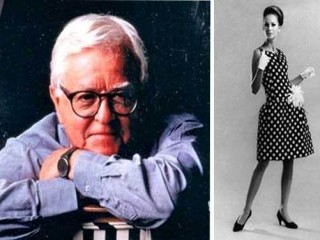
Geoffrey Beene biography
Date of birth : 1924-08-30
Date of death : 2004-09-28
Birthplace : Haynesville, Louisiana, U.S.A.
Nationality : American
Category : Arts and Entertainment
Last modified : 2022-08-30
Credited as : fashion designer, Molyneux,
2 votes so far
On June 23, 2021, it was announced that the Geoffrey Beene brand would be sold to Authentic Brands Group alongside Van Heusen, Izod, and Arrow. The sale closed on August 2, 2021, with United Legwear & Apparel Company named as its licensee.
Beene was born in 1927, and grew up in Haynesville, Louisiana. He came from a family of physicians, and duly entered the medical-school curriculum at Tulane University in New Orleans. But he sketched evening dresses during class, and later admitted that he had always been entranced by design; at the age of eight, he bought a pattern for beach pajamas at the local store, brought it to his aunt, and directed her to sew them in a blue and orange floral fabric he had selected. He eventually dropped out of Tulane, not long after his class began their cadaver work, and headed to California. He had planned to enroll in college there, but instead took a job as a window-display associate at I. Magnin, a high-end retailer.
In 1947, at the age of 20, Beene moved to New York City and enrolled at the Traphagen School of Fashion. From there, he went to Paris, where he learned the art of tailoring from a master who had once worked for the renowned house of Molyneux. Back in New York City in 1951, he landed a job at a small design atelier located inside the posh Sherry-Netherland Hotel, but lost it when his sandwich dripped onto an expensive antique chair. He headed over to the less elegant world of New York's Garment District, and from 1954 to 1963 was a designer for Teal Traina, a women's clothing firm. In 1963, he launched his own company, and put his own name on the label, which was a somewhat unusual move at the time, for few American designers operated under their own name. Generally, they worked for a manufacturer, whose name was the label.
This first phase of Beene's career was marked by standard Seventh Avenue fare. "He had achieved modest success with stiff, structured dresses that had a high waistline, a paper-doll silhouette that was widely copied," wrote New York Times critic Anne-Marie Schiro. In 1967, he designed the wedding dress for one of the daughters of President Lyndon B. Johnson, but had a change of heart regarding his design style when an essay by the New Yorker 's Kennedy Fraser likened his dresses to concrete. He decided to move forward with the times, and began creating fluid, minimalist dresses that became a favorite of the fashion editors and tastemakers of Manhattan.
Beene's best work often featured undulating seams that moved with the wearer, as well as an unusual mix of fabrics. In 1974, he launched a secondary line, called Beene Bag, which made him one of the first American designers to enter the so-called "bridge" segment of the market. He was also the first American designer to show his work during Milan's fashion week in the mid-1970s, several years before the Italian city became one of the required stops for fashion-magazine editors and retail buyers on the biannual circuit of runway shows.
Beene, however, never attained the stratospheric financial success of other American designers, partly because of a long-running feud with Women's Wear Daily, the industry bible. It began in 1967, when he refused to provide the requested advance details of Lynda Bird Johnson's wedding dress, but he later noted that coverage of his designs was absent from WWD because he could not afford to buy lavish advertising space in its sister publication, W. Despite the freeze, Beene's runway presentations of his latest spring and autumn collections at the Pierre Hotel were well-attended affairs in the 1980s. Much of his company, it was said, was financed by his hugely popular men's fragrance, Grey Flannel, one of the few license agreements he had made.
Over the years, Beene's work remained contemporary in spirit, and even increasingly minimalist in construction. He was widely cited by a younger generation of modernist designers as an early inspiration. "The more you learn about clothes, the more you realise what has to be left off. Cut and line become increasingly important, Independent writer Iain R. Webb quoted him as saying. He was also known for his strong pronouncements on style and design, once asserting, for example, that "dressing for success is something unsuccessful women do," according to the Independent 's Watson.
Beene was a well-known figure in fashion, with his signature owlish black glasses, and was honored by his peers several times over during his career; he won several Coty awards and received awards from the Council of Fashion Designers of America four times, including one in 1998 for lifetime achievement. He lived in a duplex on New York's Upper East Side, and also had a weekend home on Long Island's Oyster Bay, where he cultivated rare orchids in an extensive greenhouse. He died on September 28, 2004, in New York City at the age of 77, of complications from pneumonia, and is survived by a sister in Texas. "Beene was a rarity," a writer for the Times of London declared in tribute. "Possessed of a strong intellect, an undeviating purity of vision and the painstaking obsession of the true craftsman, he was not just a fashion designer. It is more accurate to call him an industrial designer who happened to create clothes."
















